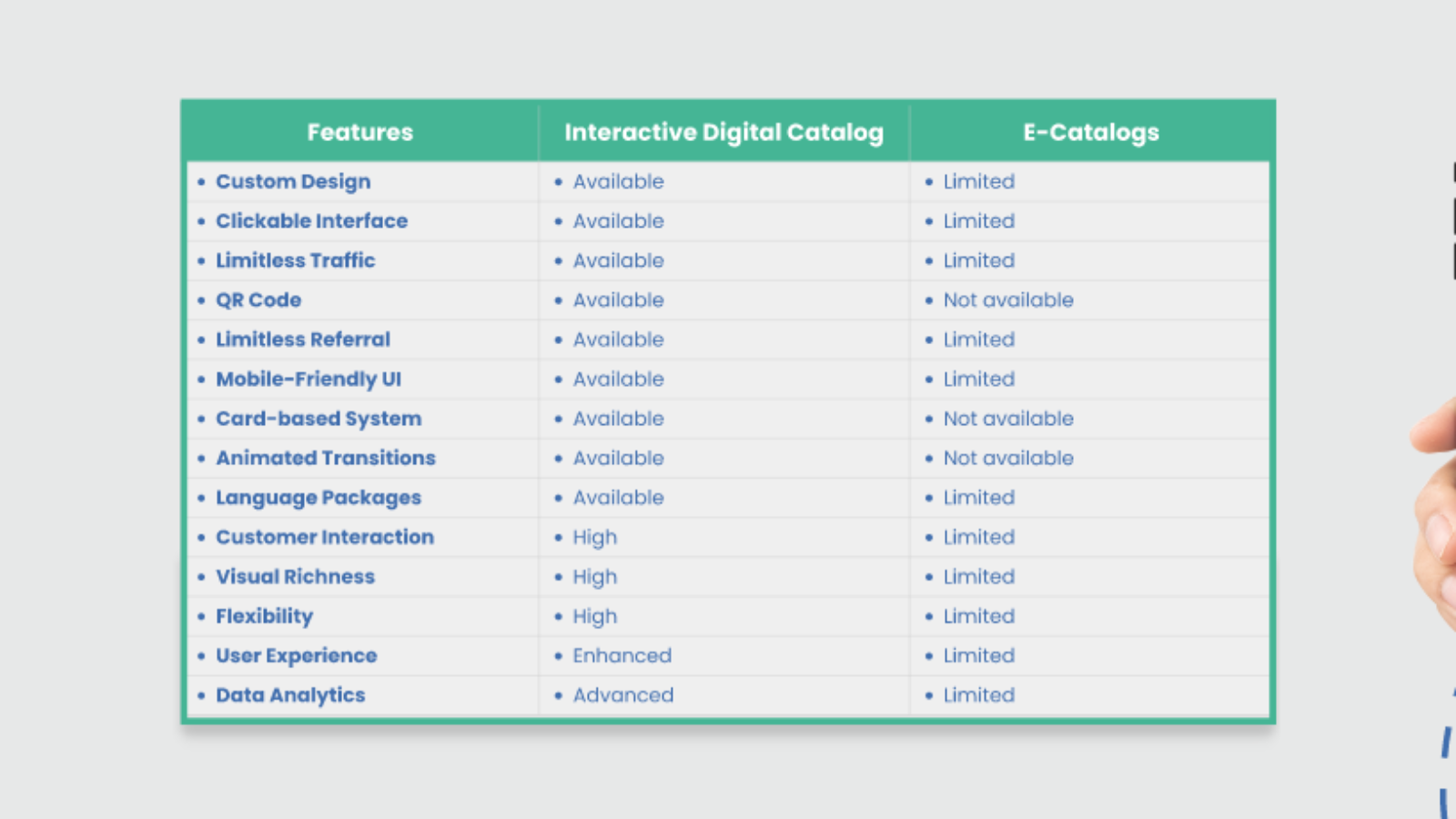Digital formats replacing traditional catalogs offer various features to make product and service presentations more engaging and dynamic. Here are the key differences between Interactive Digital Catalogs and E-Catalogs:
- Custom Design
- Interactive Digital Catalog: Offering businesses a broad creative space in terms of custom design, these catalogs are highly flexible in providing a unique appearance that reflects your brand identity and captures the interest of your target audience. Color palettes, typography, backgrounds, and other design elements can be entirely personalized.
- E-Catalog: E-Catalogs also offer the possibility of custom design, but they might not provide as extensive a range as Interactive Digital Catalogs. E-Catalogs often come with more limited design options and typically feature text and images within a simple layout. Customization choices could be restricted when it comes to adding dynamic elements like animations or interactions.
- Clickable Interface:
- In terms of clickable interfaces, interactive digital catalogs offer a wide range to enable users to explore products or services more effectively. Such catalogs allow users to quickly access desired information by clicking on visual and text content.
- E-Catalog: E-Catalogs also provide clickable interfaces, but they usually adopt a simpler approach. Users can access products or services by clicking on basic links and images, but they are limited in providing in-depth interaction or thorough exploration.
3.Unlimited Traffic:
- Interactive Digital Catalog: Enables businesses to maximize the advantage of unlimited traffic. Hosted on an online platform, it provides access to the catalog for users and potential customers without any geographical restrictions. This ensures that even if the audience for your catalog expands, there won’t be issues with accessibility or performance.
- E-Catalog: In this case, when a large number of visitors or users try to access it simultaneously, performance issues or additional costs might arise. Therefore, for businesses catering to a wide audience, traffic management can be an important factor to consider.
4.QR Code:
- Interactive Digital Catalog: Enhances user experience by allowing more effective use of QR codes. It offers advantages such as exclusive offers, quick access, and interactive content. This can encourage users to explore your products and services more deeply and engage with them.
- E-Catalog: E-Catalogs can also incorporate QR code integration to encourage users to interact more with products or services. However, they are limited in providing as broad a range as Interactive Digital Catalogs. QR codes are often used to direct users to pages containing basic information.
5.Unlimited Navigation:
- Interactive Digital Catalog: Maximizes the user experience by offering unlimited navigation options. Users can easily access the information they desire while exploring every aspect of products or services.
- E-Catalog: E-Catalogs also provide navigation features to assist users in exploring content. However, they may have limitations such as not offering unlimited navigation options or being limited for more complex interactions.
6.Mobile-Friendly Interface:
- Interactive Digital Catalog: Through its mobile-friendly interface, it enables users to seamlessly view content on various mobile devices. Interaction on touch screens and quick navigation options allow users to explore content more comfortably.
- E-Catalog: E-Catalogs also offer mobile-friendly interfaces, but they might not provide as extensive a range of mobile-compatible features as Interactive Digital Catalogs. In some cases, content irregularities or elements that are not mobile-compatible could negatively impact the user experience.
7.Card-Based System:
- Interactive Digital Catalog: Enhances the user experience with card-based system features. Users can create accounts and utilize functions like marking or saving content. This allows users to manage content more effectively and attain a more efficient experience.
- E-Catalog: Typically, E-Catalogs do not offer card-based system features. They usually allow users to view content anonymously but are more limited in terms of storing personal preferences or customization.
8.Animated Transitions:
- Interactive Digital Catalog: By offering a wider range of animated transitions, it provides an advantage in presenting content in a more captivating manner. Users can enjoy a more engaging experience while exploring content with the help of animations.
- E-Catalog: E-Catalogs can also offer animated transitions, but they are usually more basic and limited. In these catalogs, animations might be less pronounced and often aim to enhance the visual appeal of the content.
9.Language Packages:
- Interactive Digital Catalog: Provides an advantage for businesses targeting international markets with multi-language support and a wide range of language package options. Users can translate the content of the catalog into their preferred language, making the content accessible to a broader user base.
- E-Catalog: E-Catalogs can also offer language packages, but they might not be as flexible as Interactive Digital Catalogs in terms of language options and multi-language support. In some cases, limited language choices or translation quality could negatively affect the user experience.
10.Customer Interaction:
- Interactive Digital Catalog: Facilitates deeper user engagement with richer customer interaction. By incorporating visual, auditory, and interactive elements, it makes the content more dynamic and engaging. Users can examine products and services more comprehensively, enabling them to make more informed decisions.
- E-Catalog: Provides users with basic links and clickable images to view content. However, it doesn’t have the potential to offer as rich an interaction as Interactive Digital Catalogs.
11.Visual Richness:
- Interactive Digital Catalog: Enhances content by offering extensive visual richness options. High-quality images, videos, and animations allow users to visually examine products or services in greater detail.
- E-Catalog: Visual content is typically limited to clickable images or basic visual elements. The potential to include more complex visual elements or interactive content is lower.
12.Flexibility:
- Interactive Digital Catalog: Provides a broader range of flexibility, allowing you to arrange and customize content as desired. With animations, interactive elements, and various layout options, you can make the content more dynamic and engaging.
- E-Catalog: Offers flexibility, but it might not have the same potential as Interactive Digital Catalogs for extensive customization and layout capabilities. It generally takes a more basic approach to visual customization and content updates.
13.User Experience:
- Interactive Digital Catalog: Facilitates deeper exploration of content by providing a richer and interactive user experience. Animations, interactive elements, and visual richness help users understand and experience the content more effectively.
- E-Catalog: Enables users to view content through basic presentations and clickable images, but it might not offer the same level of interactivity or visual richness as Interactive Digital Catalogs.
14.Data Analytics:
- Interactive Digital Catalog: Offers more comprehensive data analytics features, providing detailed insights into user behavior. Tracking, analysis, and reporting options offer valuable information to optimize content and enhance the user experience.
- E-Catalog: Useful for tracking user interactions and collecting basic statistics, but it might not have the same potential as Interactive Digital Catalogs for providing detailed analytical options.
Interactive Digital Catalogs offer advantages over E-Catalogs, such as greater visual diversity, interactive content, and comprehensive data analytics. This enriches the user experience in unprecedented ways.


Add a Comment